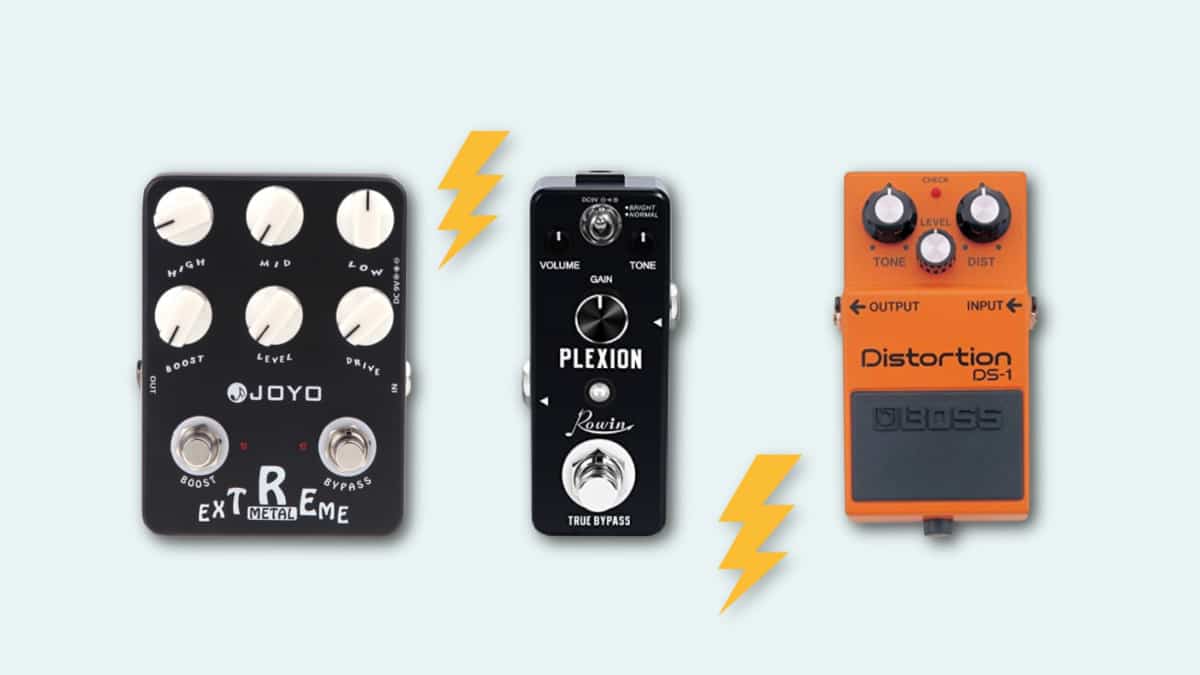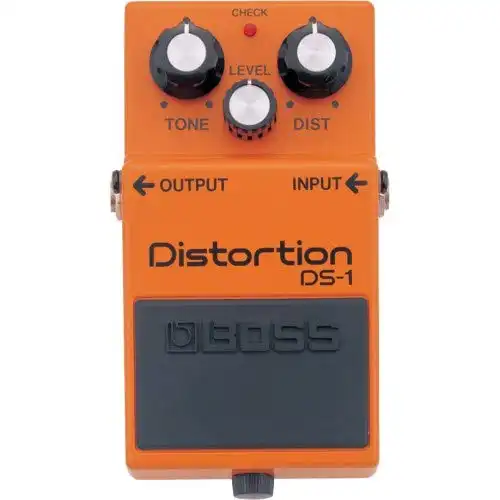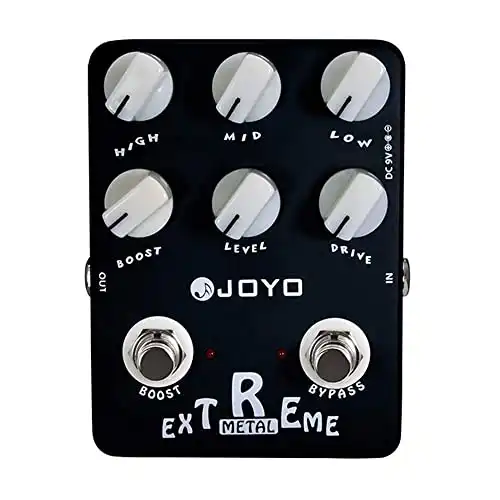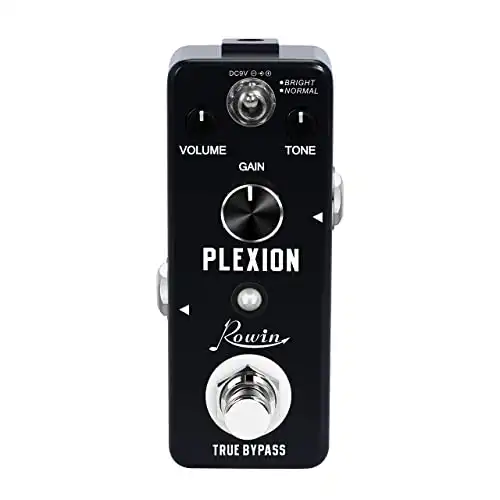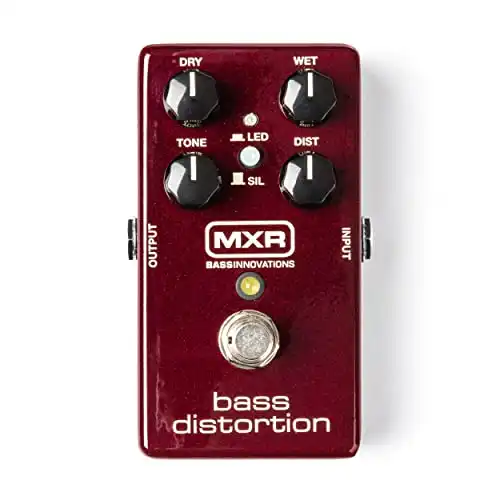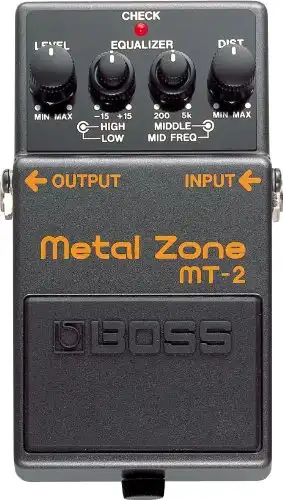Wanna cut to the chase? I went searching for the best bass distortion pedal, and my top pick was the BOSS Distortion Guitar Pedal, Single Mode (DS-1).
Some people think rocking out on an effects pedal is strictly for lead guitarists. But what about bass solos?
There are plenty of pedals on the market for bass players to have fun and experiment with, one option being bass distortion.
Whether you’re a complete bass novice or an expert seeking to upgrade your current setup, you may find a good option on my list of the best bass distortion pedals.
Further down you’ll fine a buyer’s guide which answers common questions about bass distortion pedals.
Top Pick: BOSS Distortion Guitar Pedal, Single Mode (DS-1)
If you want to switch up your sound as soon as possible without wasting time on weighing up your options, consider trying out the Boss Ds-1 bundle.
This kit boasts not just a pedal, but all of the accessories you need to rock out on a budget, achieving classic, affordable live distortion.
Offering those memorable BOSS distortion tones, users are able to tailor their own sound, capable of delivering the right sound whatever genre they play.
Included in the box are the pedal itself, a Gearlux connecting cable, patch cable, complimentary picks and a patented Austin Bazaar polishing cloth.
You might enjoy playing around with the three sound settings, which are adjustable to fulfill the needs of any bass player, though there isn’t a specific fuzz knob.
Compact and portable at 9 x 4 x 6 inches and a svelte 1.63 pounds, its luminous orange exterior also means you’re unlikely to lose it playing shows.
With a warranty of five years, if you find the product unsatisfactory or have any issues, it’s easy to resolve them for free.
Supplied by either batteries or a PSA-120S Power Adapter, you’ll be able to hook it up to your bass whether at home or on the go.
What I Like
- Operates on batteries or via an outlet
- Includes setup diagram for easy installation
- Accessories included – no need to buy any extras
- Durable enough to withstand plenty of heavy use
What I Don’t Like
- No dedicated fuzz adjustment
Editor’s Choice: JOYO JF-17 Extreme Distortion Pedal
With fourteen years of experience producing distortion kits, the team at JOYO have refined their Extreme pedal based on the feedback of many customers
.As a result, it is a popular option amongst bass players, providing strong low frequencies and transparent high notes.
Six knobs for adjusting frequency, boost, level and drive allow you to curate your own individual sound, finetuning your performance.
Built from high-quality aluminum alloy with industry standard, precision components, it’s durable and should withstand long term use.
An eighteen month warranty ensures you can solve any potential issues you might have without needing to pay for potential returns or replacements.
Supposedly intended as an imitation or ‘dupe’ of the well known Big Muff pedal, this little distorter offers the punch of a fancier model at a third of the price.
Customers report that maximum potential gain is delivered, ensuring the crunchiest tone for the dirtiest metal musicians.No matter what genre of music you play, you should find you achieve a solid sound, whether clean or dirty.
What I Like
- Plenty of settings to adjust
- Treble boost for clean signals
- Powered by battery or outlet
- Affordable and powerful
What I Don’t Like
- It’s a clone of another product, even if it’s a good one.
Best Value: Rowin Plexion Distortion Pedal
With a dedicated true bypass function, your signals will remain fully intact, passing through the Plexion Distortion Pedal without a loss of frequency.
Three knobs allow you to modify gain, tone, and volume, allowing for those dirty distorted sounds you might be looking for.
You can toggle a switch between bright and normal channels – bright is better for sustained, distortion, particularly when you turn up the gain.
Constructed from sturdy zinc alloy, it’s nice and solid, suitable for repeated use and getting bumped around at shows.
Shorter and narrower than most pedals, it’s easy to slip into your carry case, so you won’t run out of space on your pedal board.
What I Like
- Clear sound, distorted crisply
- Low budget, yet powerful
- Built in noise gate prevents distortion from amp and cords
- Can be used to tune your bass
What I Don’t Like
- Power cord and batteries are not included
Runner Up: MXR M85 Bass Distortion Pedal
A result of MXR’s wish to create something a little more extreme, the M85 is a collaboration with Fuzzrocious Pedals founder Ryan Ratajski.
Intending to hit levels of intensity most distortion pedals couldn’t manage, the dry and wet level knobs really let you control and alter the sound.
A default silicon setting uses silicon clipping diodes to alter your sound, whilst LED diodes can be selected to increase your gain even higher.
Without needing to split your signals, you can achieve the sound of a clean and dirty signal chain with just a single box.
Teeny tiny at 5.5 x 4.4 x 2.5 inches and weighing a measly 11.6 ounces, this pedal packs a surprisingly mighty punch you might not expect.
Powered by either a 9v battery or a DC power supply (sold separately), you’ll be able to mess around with your bass at home, on the go, and at shows.
What I Like
- Multiple settings to try out
- Lightweight but sturdy
- Gain levels are maximised internally
- Select the clipping diodes you prefer
What I Don’t Like
- Batteries and power cord are not included
Runner Up: Boss MT-2 Metal Zone Distortion Guitar Pedal
One of the most popular offerings from BOSS, their MT-2 Metal Zone Distortion pedal offers distortion with huge mids and lows.
Providing an ultra-saturated sound to please all bass players, a three band EQ with semi-parametric mid controls allows for a range of distortion textures.
Four knobs allow you to control the levels, alongside an in-built equalizer with high, mid and low frequency for a fully customizable sound.
An attractive black and orange exterior is distinguishable from other more generic pedals, so you’re less likely to lose it. Only 73 millimeters tall and almost nothing at 410g, it’s portable and easy enough to carry around to band practice or, if you’re lucky, a show.
A single 9v battery is all you need for power, and is included in the box, but you can pick up an AC adaptor if you’d prefer not having to replace a battery.
The typical five year BOSS warranty is provided to ensure that you as the customer are satisfied with the pedal you receive, and to rectify issues as soon as possible.
What I Like
- Perfect for hard rock and metal guitarists
- Unique dual-gain circuitry for a clean sound overall
- Batteries are included with your purchase
- Offers extended sustain alongside heavy mids and lows
What I Don’t Like
- Can’t adjust volume
Best Bass Distortion Pedals Buying Guide
Defined simply, bass distortion involves inputting a source signal into an audio circuit and increasing the gain.
This is done until the circuit can no longer replicate the signal being received, resulting in a clipped waveform and saturated sounds.
Now that you’ve had a look at the pedals I’ve laid out, if you’re still not sure which one makes for the best distortion this section may help.
Messing around on your bass might not feel particularly scientific, but there are a few key words you’re going to want to understand before you begin.
For example: tone, gain and sustain
Tone
A bass guitar’s tone or timbre is the quality or character of a musical sound, not to be mistaken with its pitch (from low to high) or intensity (how deep the sound is). For example, adjectives to describe tone might include smooth, rough, smoky, flat and heavy.
Gain
Sometimes falsely understood as referring to volume, the gain setting determines how hard the pre-amp section of your amplifier is working.
Adjusting this will also impact on the amount of distortion you experience altogether.In layman’s terms, gain is how ‘clean’ or ‘dirty’ your sound comes through, regardless of the master volume’s level.
You can have a quiet dirty sound, or a loud clean sound, and each is controlled with the handy gain knob.
Sustain
As the name suggests, a bass guitar’s level of sustain essentially means the level of endurance of a string’s vibration. The higher your sustain is, the more time your string vibrates for, and the longer a note will hold without dying out.
Overdrive, fuzz and distortion: what’s the difference?
As mentioned above, distortion involves altering a sound’s wavelength before the note is even heard, through ‘clipping’.It is also used interchangeably with the terms fuzz and overdrive as other ways to change how a bass sounds. What are they?
Overdrive
An overdrive pedal is designed to boost your amplifier’s existing valves into distorting more, as the name might suggest.
It’s a simple standalone effect that increases your midrange and provides some grit to the bass sound produced.
It is most effective when dialed into a sterile bass tone, helping bring life to a particularly boring sound.
Make sure you start with a lighter touch to begin with and build up as you go.
Otherwise you’ll end up with a messy, chaotic sound.
Fuzz
Aiming for a harsher saturation of sound, you’re creating a sound antithetical to the softer, more harmonic clipping that occurs from distortion and overdrive.
This helps to mimic the more old-school synth sounds as well as limiting transients – which are simply non-repeating waveforms – that sound harsh on the ear.
Here’s a video to give you a better idea.
Why bother with a pedal?
What can you gain from a distortion pedal that a regular bass sound won’t provide?
For a start, they open up a whole world of lower frequencies with which to distort your sound, far from the brighter tones you might be used to.
Likewise, a distortion pedal will increase your sustain level, meaning that the notes you play will vibrate for longer. They will also sound crisper, bringing a level of continuity to your music.
Should you play in a band and wish to shake things up with your next bass solo, a distortion pedal can be a great way to introduce some new sounds.
An ability to add wild and crazy twists to your rocking out might help in impressing your audience, if you have one.
Headroom
An important factor to consider when picking up a distortion pedal is the amount of headroom it is capable of. Basically, this means how high or how low the pedal can clip your signal, and thus how ‘dirty’ your sound will be.
Usually measured in dB (decibels) or kHz (kilohertz) by manufacturers, the higher your headroom, the more range you’ll have.
Range here refers to how far the sound can be distorted and whether it will be jarring to the ear.
Size and style
Distortion pedals are available in a variety of shapes and sizes, but their aesthetic qualities usually serve no purpose in terms of how the pedal functions.
Regarding size, your only question should be whether it will fit in your current pedalboard setup or not. The more knobs and buttons and settings a distortion pedal offers, the more experimentation you’ll be able to perform and the greater range of sound.
If playing around is your cup of tea, pick a pedal with plenty of options.
FAQs
What does audio distortion sound like?
As explained earlier in the article, distortion, overdrive, and fuzz are forms of audio signal processing that serve to impact the sound of your bass.
By increasing the gain, you can produce a ‘gritty’, ‘dirty’, ‘fuzzy’ or ‘growling’ tone. Also described as ‘warm’, the clipped signals, pushed past their maximums, are boosted with sustain.
This creates a compressed sound with harmonic and inharmonic overtones, depending on the type and intensity of distortion used.
How do you get crunchy distortion?
‘Crunchy’ distortion is just another way of saying that a lot of distortion is occurring, as determined by the amount of gain and distortion you have while playing. Increase your gain and turn up that distortion for maximum crunch!
How do you get a good distorted bass tone?
At its most basic, a distorted bass tone is best achieved by running two signals at once: a clean one and a dirty one. If those lower frequencies are distorted too much, the sound will lose its crispness and you’ll struggle for precision with your notes.
Splitting your signal into two chains with a splitter (or two amps if you’re desperate) and using each for a different purpose, works best.
You combine clean low frequencies and higher, bassier notes, without losing sound quality.If you only have the capability for distorting one signal, using a distortion pedal built specifically for use with a bass guitar is better.
Using pedals made for a bass in particular increases the likelihood of hitting that low, rumbling sweet spot.
Similarly, a bass amplifier works better than one built for general use, as they’ll keep the sound clean and simple.
Some even have built-in distortion features, which will save you from needing to pick up a pedal if you don’t have the spare cash.
Why does my distortion pedal sound bad?
There are a couple of reasons your distortion pedal might be failing to create the sound you’re looking for.
You could even be producing an entirely new and horrible sound you never wanted. An easy fix is to check your cable connections – is everything plugged in tightly and into the correct sockets?
Is there any visible fraying or damage to the wires?
Try switching out the set you’re using for some fresh ones and see if that helps.
Your amp could be the problem, not necessarily your distortion pedal.
If your amplifier is cheap, poor quality or doesn’t produce a nice sound on it’s own, you’ll struggle to achieve that dirty distortion you’re looking for.
It may also be that your amp has an in built noise gate, a feature manufacturers include to actually prevent sound distortion.
With a gate in place to prevent any alterations to the sound’s signal, you’ll be robbed of precious tone.
If your volume is kept to a minimum to prevent angry neighbors or avoid feedback, it could be making your sound ‘thinner’.
I recommend increasing your volume and turning down your gain, adjusting while you play based on the sound.
Final thoughts
I hope you found my reviews of the best bass distortion pedals helpful!
If you wanna check out some other cools equipment, feel free to peruse my reviews of the best EQ pedals for guitar, best pedals for your acoustic guitar, or the best 8-string guitars.
Happy strumming! 🙂






